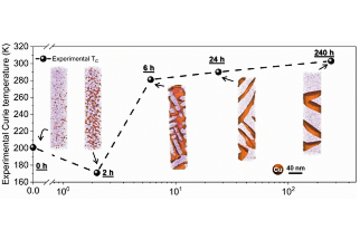All genres
2441.
Thesis - PhD
Lattice Boltzmann modeling of advection-diffusion-reaction equations in non-equilibrium transport processes. Dissertation, RWTH Aachen, Aachen, Germany (2013)
2442.
Thesis - PhD
A constitutive model of twin nucleation and deformation twinning in High-Manganese Austenitic TWIP steels. Dissertation, RWTH Aachen, Aachen, Germany (2013)
2443.
Thesis - PhD
Elastic and plastic properties of fcc Fe–Mn based alloys. Dissertation, RWTH Aachen, Aachen, Germany (2013)
2444.
Thesis - PhD
Mechanics in Steel through Microscopy. Dissertation, TU Delft, Delft, The Netherlands (2013)
2445.
Thesis - PhD
Relation between microstructure and mechanical properties of a low-alloyed TRIP steel. Dissertation, RWTH Aachen, Aachen, Germany (2013)
2446.
Thesis - PhD
On the growth and mechanical properties of non-oxide perovskites and the spontaneous growth of soft metal nanowhiskers. Dissertation, RWTH Aachen, Aachen, Germany (2013)
2447.
Thesis - PhD
Grain boundary motion in polycrystalline materials. Dissertation, Ruhr-University Bochum, Bochum, Germany (2013)
2448.
Thesis - PhD
Characterization of crystal defects during molecular dynamics simulations of mechanical deformation. Dissertation, Ruhr-University Bochum, Bochum, Germany (2012)
2449.
Thesis - PhD
Discrete dislocation dynamics simulations of dislocation-low angle grain boundary interactions. Dissertation, RWTH Aachen, Aachen, Germany (2012)
2450.
Thesis - PhD
Nanoscale austenite reversion through partitioning, segregation and kinetic freezing. Dissertation, RWTH Aachen, Aachen, Germany (2012)
2451.
Thesis - PhD
Towards designing elastic and magnetic properties of Co-based thin film metallic glasses. Dissertation, RWTH Aachen, Aachen, Germany (2012)
2452.
Thesis - PhD
First-principles investigations of solid solution strengthening in Al alloys. Dissertation, RWTH Aachen, Aachen, Germany (2011)
2453.
Thesis - PhD
Measurement of residual elastic strain and lattice rotations with high resolution electron backscatter diffraction. Dissertation, Oxford University, Oxford, UK (2011)
2454.
Thesis - PhD
Microstructure characterization of ultra-fine grained Cu–0.17wt.%Zr. Dissertation, RWTH Aachen, Aachen, Germany (2011)
2455.
Thesis - PhD
Microstructure and properties of interfaces formed by explosion cladding of Titanium to low Carbon steel. Dissertation, Ruhr-University Bochum, Bochum, Germany (2011)
2456.
Thesis - PhD
Mechanische Eigenschaften von Laves-Phasen in Abhängigkeit von Kristallstruktur und Zusammensetzung am Beispiel der Systeme Fe–Nb–Al und Co–Nb. Dissertation, RWTH Aachen, Aachen, Germany (2011)
2457.
Thesis - PhD
Mechanism Maps, Mechanical Properties, and Flow Behavior in High-Manganese TRIP/TWIP and TWIP steels. Dissertation, RWTH Aachen, Aachen, Germany (2011)
2458.
Thesis - PhD
Fundamental Research into the Role of Intermetallic Phases in Joining of Aluminium Alloys to Steel. Dissertation, Ruhr-University Bochum, Bochum, Germany (2011)
2459.
Thesis - PhD
Deformation and recrystallization behaviour of Fe–Mn–C alloys. Dissertation, RWTH Aachen, Aachen, Germany (2011)
2460.
Thesis - PhD
Micromechanical Modeling of Gamma-TiAl - based alloys. Dissertation, RWTH Aachen, Aachen, Germany (2010)











